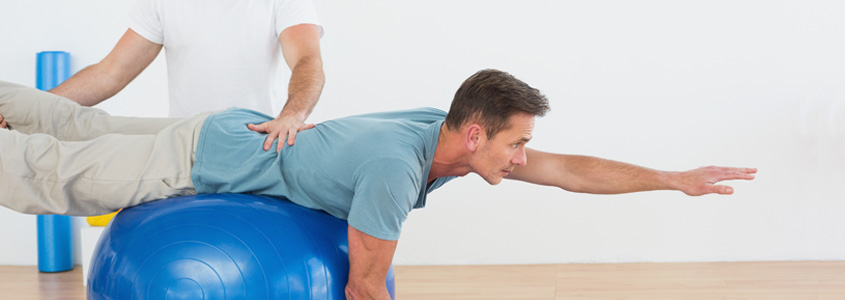The World Health Organization estimates the lifetime prevalence of non-specific low back pain will affect 60-70% of individuals. Low back pain is also the leading cause of limited activity and one of the most common reasons for missing work. Physical therapy is known to be very effective in treating low back pain. Whether through exercises, stretches, manual interventions, or a combination of the three, physical therapy will help you learn more about the possible cause of your low back pain and how to decrease or omit the pain. When you complete your course of physical therapy, it’s possible you still might have a little pain, but you will have exercises and other tools to help manage or improve any residual pain.
But what if you want something more you can do on your own to maintain all of the gains you achieved in physical therapy? What if you now feel you are able to exercise more, but you aren’t sure what would be a good type of exercise to continue targeting your chronic low back pain? While there are many ways to continue getting stronger and more active to manage residual pain, one well researched type of exercise stands out: Yoga.

How Yoga Can Help Alleviate Lower Back Pain
Yoga is something we all have different opinions on. Some of us love it and practice it daily, others aren’t fond of the idea as it seems far too easy. Then there are those of us who dabble in it here and there but have never really committed. But if there’s one thing all of us can agree on, it’s that yoga is good for you. But what is it that makes it so good for you? Is it all the stretching? The calming effect that accompanies it? The core stabilization? Yes to all of the above, and one more that we don’t always think about – the benefits of helping manage chronic low back pain.
There have been numerous studies examining the connection between yoga and the benefits it provides to managing low back pain. The general consensus is that yoga is a safe and effective method to reduce pain and improve confidence.
Why Yoga Is Helpful for Managing Chronic Pain
Yoga has been around for thousands of years. It is a practice that encompasses several different components: strengthening, stretching, postural awareness poses, relaxation and meditation, and breathing techniques. Research shows that the approach of combining mind and body for the treatment of chronic pain is much more effective than only focusing on the pain and exercises or medication to treat it. Yoga is a perfect melding of this biophysiological approach of addressing chronic pain.
Another positive aspect of yoga is the many different types of yoga that enables one to choose the style that works best for them. Additionally, each pose the teacher instructs you to achieve is just a suggestion. If a pose does not feel good to you, there are modifications you can make for improved comfort. Instructors encourage you to listen to your body and only practice poses that feel right for you.

A few of the most common types of yoga:
Hatha
- A great type of yoga for beginners, Hatha yoga is a slow paced class focused on learning different postures and focusing on breathing techniques. This technique will build on the core stabilization exercises you learned in physical therapy. You will work on maintaining a stable core and holding it for prolonged time during different positions.
Restorative
- Restorative yoga uses props such as blankets and blocks to enable you to easily rest into poses without having to put forth too much effort. You will work on holding deep stretches for several minutes to achieve the maximum benefit. These classes can be very calming and are a good way to unwind after a long week of work.
Vinyasa
- No two Vinyasa classes are the same, so if you dislike routine this may be the class for you. This style of yoga focuses on fluid movement between poses while focusing on breathing techniques linked to each move. You will work on challenge your core stability while smoothly transitioning from pose to pose.
If none of these styles sound like they’re up your alley not to worry. There are several more traditional styles not listed above that may fit into your goals and preferred exercise method. There are also quite a few non-traditional styles of yoga including aerial yoga, stand up paddleboard yoga, acro yoga, and goat yoga – yes, this style has baby goats joining you all through the class.
Yoga is an all inclusive style of exercise that can benefit anyone who is willing to give it a try. So if you still have occasional nagging low back pain, it might be worth signing up for a yoga class or two at your local gym after completing your physical therapy course of care. Talk to us and we can help you find a yoga instructor or studio that is right for you. If you find that you enjoy it, it can be a great way to keep your mind and body healthy throughout your entire life.

Summary:
Yoga not only increases your flexibility and core strength, it also improves your confidence. Simply knowing that you have the power to manage your residual low back pain can make a monumental difference when it comes to the frustration that can accompany the seemingly never ending battle of low back pain.
Whether you choose to stick with yoga videos you can complete in the privacy of your living room, or venture out to an Ashtanga or a Hot Yoga class, you now know you are doing even more for your health and well being.
The physical therapists at Rose City Physical Therapy would love to work with you and help guide you along a functional program targeted at addressing your low back pain. After completing your course of physical therapy, we would be happy to help connect you with local yoga studios with instructors that will guide you through yoga poses and techniques suited to your individual goals.
REFERENCES:
httpss://www.ncbi.nlm.nih.gov/pmc/articles/PMC4878447/
Chang DG, Holt JA, Sklar M, Groessl EJ. Yoga as a treatment for chronic low back pain: A systematic review of the literature. J Orthop Rheumatol. 2016;3(1):1–8.
httpss://www.ncbi.nlm.nih.gov/pmc/articles/PMC3805350/
Holtzman, S., & Beggs, R. T. (2013). Yoga for chronic low back pain: a meta-analysis of randomized controlled trials. Pain research & management, 18(5), 267–272.
httpss://www.gaiam.com/blogs/discover/a-beginners-guide-to-8-major-styles-of-yoga
httpss://www.doyouyoga.com/the-4-most-popular-types-of-yoga-explained/
httpss://www.who.int/medicines/areas/priority_medicines/Ch6_24LBP.pdf

